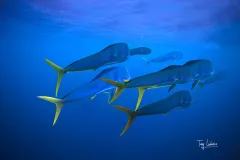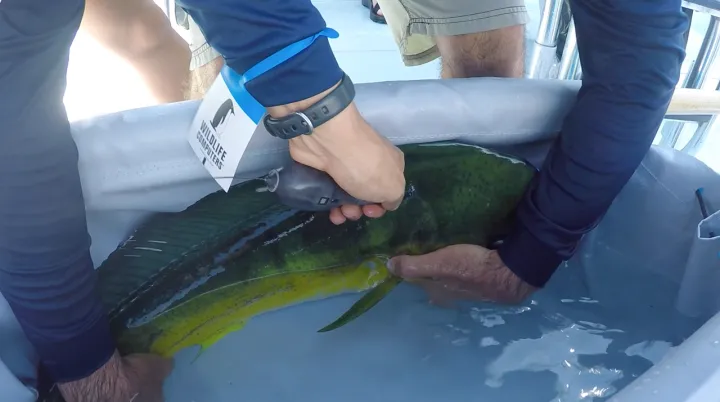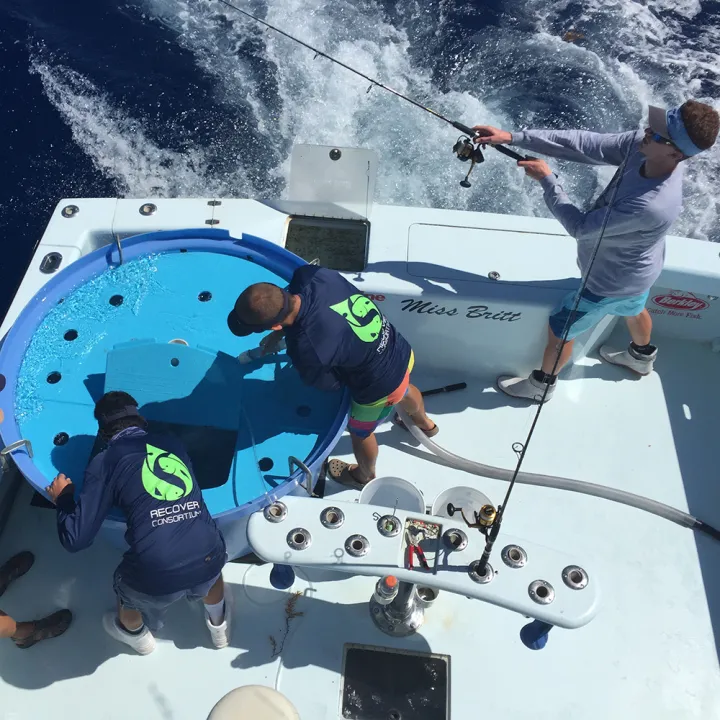From Larvae to Adults – Finding Impacts of an Oil Spill on Mahi-Mahi

For a month during the summer of 2016, Lela Schlenker spent several hours in the dead of night watching mahi-mahi and waiting to catch them in the act. The colorful and large fish spawn in the cloak of darkness, and she needed to say with certainty when fish sex was occurring (in the form of broadcast spawning). Every night she would peer into an 8,000 gallon tank (30, 283 liters) at the University of Miami from around midnight to 3 a.m. and look for the release of eggs and sperm. She had to be there in person—to see properly in a video would require lighting that might spook the fish and cause some performance anxiety.
The reason for these middle-of-the-night sessions was to collect information in the lab that could be later applied to determine how exposure to oil during a spill, like the Deepwater Horizon oil spill off the Gulf of Mexico coast in 2010, might impact fish physiology and behavior, specifically spawning. Schlenker is a PhD student with RECOVER (Relationships of Effects of Cardiac Outcomes in fish for Validation of Ecological Risk)—a research group funded by the Gulf of Mexico Research Initiative (GoMRI) exploring the questions of oil spill impacts on mahi-mahi and red drum, two of the many fish species that live in waters of the Gulf of Mexico and play important roles in both the ecosystem and the economy.
Before researchers can figure out how oil and dispersant (chemicals used to help reduce impacts of the oil) may have harmed fish, they first need to learn about their normal behaviors. Martin Grosell, the Principal Investigator leading RECOVER, explains, “All the GoMRI efforts are prompted by oil spill research needs, but especially for mahi-mahi, every time we do an experiment on them—even unexposed controls without oil—it’s a first. It’s mind-blowing how much we learn.” The RECOVER team’s work looks at the entire life cycle of these fish species and from all different scientific perspectives—from molecular biology to the impacts oil and dispersant have on organ function or interactions with other fish, prey, and predators.
Prior to Deepwater Horizon, research showed that oil exposure does impact the development of fish hearts, but RECOVER is taking this knowledge a step further. They are exploring if oil and dispersant reduce a fish’s ability to see (yes, they give the fish eye tests), swim (a fish treadmill is involved), smell, spawn, and relatedly, catch prey or avoid predators.
The mahi-mahi that Schlenker observed in tanks were wearing tags that record bits of information, like water temperature, depth and light levels that can be modeled to produce GPS coordinates. Tagging fish is not a new practice; it typically is used to find out about the movement of large fish, turtles, or marine mammals. But mahi-mahi in particular are sensitive to handling and very few successful tagging studies have been done on the species. Because these fish are so sensitive, the first step for researchers was to determine if fish could recover (in a laboratory setting) from the tagging and handling process, swim well with the tags attached, and keep the tags attached. For this experiment the RECOVER team used wild mahi-mahi that had been caught and brought back to the University of Miami. Tagging the captive mahi-mahi with custom tags that feature accelerometers allowed Schlenker to match the spawning she observed in tanks to swimming behaviors and acceleration patterns seen in data from the tags. The information from those tags showed different behavior patterns occurred for male and female fish around spawning—females would suddenly speed up, and males slowed down quite a bit and would swim around in circles.
The next step—capturing and tagging 22 wild mahi-mahi—was put on hold due to boat trouble. In the meantime, the team executed some smaller scale tagging with wild fish. A male and two females (none exposed to oil during the oil spill) were successfully tagged, and in just 48 days the tag of one female showed she swam almost 3,000 miles (4,828 km), following the Gulf Stream north and eventually moving eastward. “[They’re] not gonna make a migration like that, if they have any cardiac impacts,” Grosell remarks about the long journey of the mahi-mahi and the possible repercussions of an oil spill.
After many lab experiments, RECOVER can now say with certainty that it is not only developing embryos, but also adult fish, that have physiological, reproductive, and social repercussions from contact with oil and chemical dispersants. Ongoing work is looking at these impacts on wild fish, and all of this information can help inform models. Pulling all of this information together, researchers will be able to answer questions about the survival of fish and their embryos and help to inform decisions made when oil spills occur in the future.
The research excites Grosell, “Usually you focus on a small piece as a single investigator or small group, this [RECOVER] propels us to the next level and gives us the ability to bring experts together to ask more questions.”
---
The Ocean Portal receives support from the Gulf of Mexico Research Initiative (GoMRI) to develop and share stories about GoMRI and oil spill science. The Gulf of Mexico Research Initiative (GoMRI) is a 10-year independent research program established to study the effect, and the potential associated impact, of hydrocarbon releases on the environment and public health, as well as to develop improved spill mitigation, oil detection, characterization and remediation technologies.
For more information, visit http://gulfresearchinitiative.org



